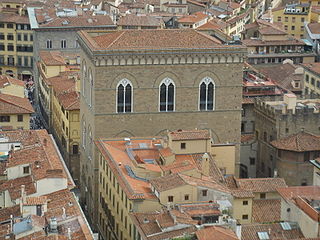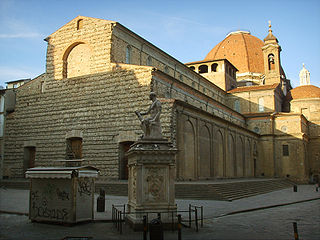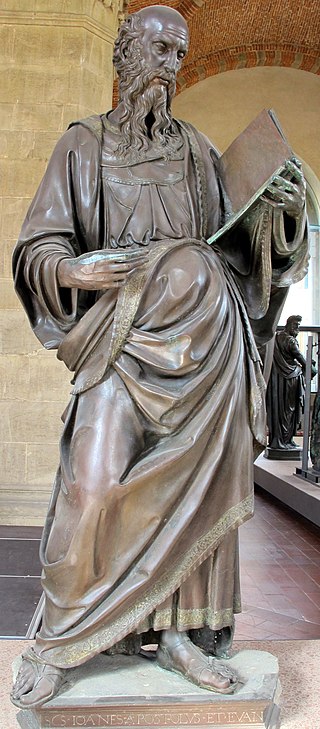
Donato di Niccolò di Betto Bardi, better known as Donatello, was an Italian sculptor of the Renaissance period. Born in Florence, he studied classical sculpture and used his knowledge to develop an Early Renaissance style of sculpture. He spent time in other cities, where he worked on commissions and taught others; his periods in Rome, Padua, and Siena introduced to other parts of Italy the techniques he had developed in the course of a long and productive career. His David was the first freestanding nude male sculpture since antiquity; like much of his work it was commissioned by the Medici family.

Orsanmichele is a church in the Italian city of Florence. The building was constructed on the site of the kitchen garden of the monastery of San Michele which no longer exists.

Jacopo della Quercia, also known as Jacopo di Pietro d'Agnolo di Guarnieri, was an Italian sculptor of the Renaissance, a contemporary of Brunelleschi, Ghiberti and Donatello. He is considered a precursor of Michelangelo.

Nanni d'Antonio di Banco was an Italian Renaissance sculptor from Florence. He was a contemporary of Donatello - both are first recorded as sculptors in the accounts of the Florence Duomo in 1406, presumably as young masters.

David is the title of two statues of the biblical hero by the Italian Early Renaissance sculptor Donatello. They consist of an early work in marble of a clothed figure (1408–09), and a far more famous bronze figure that is nude except for helmet and boots, and dates to the 1440s or later. Both are now in the Museo Nazionale del Bargello in Florence. The first was Donatello's most important commission up to that point, and had a religious context, placed on Florence Cathedral. The bronze remains his most famous work, and was made for a secular context, commissioned by the Medici family.

The Basilica di San Lorenzo is one of the largest churches of Florence, Italy, situated at the centre of the main market district of the city, and it is the burial place of all the principal members of the Medici family from Cosimo il Vecchio to Cosimo III. It is one of several churches that claim to be the oldest in Florence, having been consecrated in 393 AD, at which time it stood outside the city walls. For three hundred years it was the city's cathedral, before the official seat of the bishop was transferred to Santa Reparata.
Donatello's Saint Mark (1411–1413) is a marble statue that stands approximately 7 ft 9 in (2.36 m) high and is displayed in the museum of the Orsanmichele church, Florence. It originally was displayed in an exterior niche of the church, where a copy now stands. It depicts Mark the Evangelist.

Baccio da Montelupo, born Bartolomeo di Giovanni d'Astore dei Sinibaldi, was a sculptor of the Italian Renaissance. He is the father of another Italian sculptor, Raffaello da Montelupo. Both father and son are profiled in Vasari's Le Vite delle più eccellenti pittori, scultori, ed architettori.

The Tabernacle of the Linaioli is a marble aedicula designed by Lorenzo Ghiberti, with paintings by Fra Angelico, dating to 1432–1433. It is housed in the National Museum of San Marco, Florence, Italy.
Saint George Freeing the Princess is a marble stiacciato bas-relief sculpture by Donatello, sculpted around 1416 or 1417. It was originally situated under the same artist's Saint George on an external niche of the church of Orsanmichele in Florence; both works are now in the Bargello Museum, with replicas replacing them in their original positions.

Saint George is a marble sculpture by Donatello. It is one of fourteen sculptures commissioned by the guilds of Florence to decorate the external niches of the Orsanmichele church. St. George was commissioned by the guild of the armorers and sword makers, the Arte dei Corazzai e Spadai.

The Madonna of the Rose is a 2.2 metre high marble sculpture of the Madonna and Child enthroned, with the Child trying to take a bunch of rosa canina from his mother's hand. It forms part of a cycle of fourteen sculptures of the patron saints of the guilds of Florence on the external niches of the Orsanmichele church. No documents survive to precisely date it, leading to several theories and attributions. Most art historians attribute it to Pietro di Giovanni Tedesco, a German or Flemish sculptor active in Florence in the sculpture-yard of Florence Cathedral. It shows similarities to late works from the school of Giotto.

Four Crowned Martyrs is a sculptural group by Nanni di Banco. It forms part of a cycle of fourteen sculptures commissioned by the guilds of Florence for external niches of Orsanmichele, each sculpture showing that guild's patron saint. This sculpture was commissioned by the Arte dei Maestri di Pietra e Legname and completed around 1416-1417. It is in Apuan marble and is made of four figures of the Four Crowned Martyrs, the tallest of which is 2.03 m high. It is now indoors in the Museo di Orsanmichele, although a copy fills its original niche.

Saint Philip is an Apuan marble statue of Philip the Apostle by Nanni di Banco. It forms part of a cycle of fourteen sculptures commissioned for the external niches of Orsanmichele in Florence, each showing the patron saint of one of the city's guilds. It is 2.5 m high and was commissioned by the Arte dei Calzolai. Completed around 1410-1412, it is now in the Museo di Orsanmichele, although a replica fills its original niche.

Saint John the Evangelist is a 2.66 m high bronze statue of John the Evangelist by Baccio da Montelupo, completed in 1515. It was commissioned by the Arte della Seta as part of a cycle of fourteen sculptures for the external niches of Orsanmichele, each showing the patron saint of one of the guilds of Florence. It is now in the Museo di Orsanmichele, although a replica fills its original niche.

Saint Luke is a 2.73 m high bronze statue of Luke the Evangelist by Giambologna, commissioned by the Arte dei Giudici e Notai and completed in 1597–1602. One of a cycle of fourteen commissioned by the guilds of Florence for the external niches of Orsanmichele, it is now in the Museo di Orsanmichele, although a replica fills its original niche.

Saint Stephen is a 2.6 m high bronze statue of saint Stephen by Lorenzo Ghiberti, completed for the Arte della Lana guild in 1427–28. It is now in the Museo di Orsanmichele, although a replica fills its original niche on the exterior of Orsanmichele, where it was one of a cycle of fourteen sculptures, each showing the patron saint of one of the guilds of Florence.
Saint Eligius is an Apuan marble statue of saint Eligius by Nanni di Banco, forming part of a cycle of fourteen patron saints of the Florentine guilds for the external niches of Orsanmichele. It was commissioned by the Arte dei Maniscalchi guild and completed around 1417–1421, although it took until around 1422 for it to be put up in its niche. That niche is now filled by a replica, with the original in the Museo di Orsanmichele.

Saint Louis of Toulouse is a gilded bronze sculpture of Louis of Toulouse by Donatello with a marble niche all'antica on the facade of Orsanmichele, executed in 1423–1425. It is now in the refectory of the Museo di Santa Croce in Florence.

The following catalog of works by the Florentine sculptor Donatello is based on the monographs by H. W. Janson (1957), Ronald Lightbown (1980), and John Pope-Hennessy (1996), as well as the catalogs of the 2022/2023 exhibitions in Florence, Berlin and London. In the case of unsigned or documented works, the attributions and dates are, as is usual, based predominantly on stylistic criteria and analogies to secured works. Many of the works attributed to Donatello were created in collaboration with other artists and with specialists in specific techniques.

















